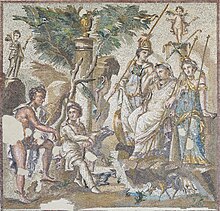Judgment of Paris (mosaic)
The judgment of Paris is the motif on a mosaic that was discovered in Antioch on the Orontes and is one of the most important mosaics from the city. It is now in the Louvre (Ma 3443) and measures 186 × 186 cm. In ancient times, it was part of a large mosaic floor with five picture fields. The other parts of the mosaic are exhibited in other museums, mainly in the USA. The mosaic field shows the judgment of Paris , an episode that led to the Trojan War . In the middle, Paris is shown seated, who should decide whether Athena , Hera or Aphrodite is the most beautiful goddess. The deities are on the right. On the far left you can see Hermes and above him a psyche . The picture is framed by a rich floral pattern depicting grapevines.
Doro Levi , who worked on the mosaic floor, saw a certain impressionistic effect in the design , especially in the play of light and shadow. The motif of the Judgment of Paris is in fact known from around six examples in Pompeian wall painting, while there are only two other examples on mosaics ( Kos and Casariche in Spain ).
The mosaic was in the dining room of an atrium house in Antioch. In total, the mosaic, which was once 7.2 × 4.8 m in size, had five picture fields. The judgment of Paris formed the central and largest field of view. The other fields represent the drinking contest of Heracles (Worcester Art Museum 1933.36), Aphrodite and Adonis (The Art Museum, Princeton University 40.156), a dancing maenad (Baltimore Museum of Art 33.51.1) and a dancing satyr (Baltimore Museum of Art 33.51 .2).
The mosaic is dated to the beginning of the second century AD.
literature
- Christine Kondoleon: Antioch, The Lost Ancient City , Princeton ISBN 0-691-04932-7 , p. 62 (reconstruction of the whole floor), 66–71, 168–175

